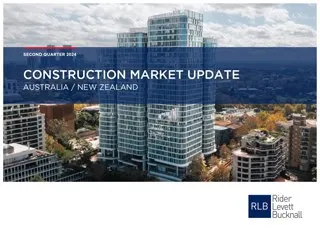According to the Rider Levett Bucknall (RLB) 2nd Quarter 2024 Oceania Report, the Australian construction industry is navigating a turbulent economic landscape in 2024.
Domenic Schiafone, Director of RLB Oceania Research & Development, stated, “The Reserve Bank of Australia (RBA) has predicted subdued economic growth coupled with a constrained labour market. This scenario suggests a continuation of the upward trend in labour costs, a critical component of overall project expenditure.”
“Further intensifying inflationary concerns is the stagnation of productivity growth within the construction sector. Since our Q1 2024 report, four of nine cities reported a rise in forecasted construction escalation for 2024, with the other five remaining steady. Overall, the rate of escalation remains significantly higher than the 4.0% CPI uplift anticipated for the full calendar year,” he added.
“Our research into construction output per worker since 2000 has found that since 2013 there has been a 26.5% increase in the number of workers within the overall construction workforce, who on average are working 2.0% fewer hours per annum and achieving a 25.4% lower output.”
Impact on project delivery
The anticipated rise in construction costs will have a significant impact on project delivery across various sectors, including public infrastructure, private sector development, and residential housing. Increased construction costs will likely lead to delays and budget overruns for public infrastructure projects, impacting essential services such as transportation, utilities, and healthcare. For private developers, the rise in construction costs will make it more challenging to deliver projects within budget, potentially leading to cancellations, delays, or a reduction in the quality of construction materials and methods. The affordability of housing is likely to deteriorate further due to rising construction costs, exacerbating the housing supply shortage and making it even more difficult for Australians to achieve homeownership.
National forces driving cost pressures
Several national key forces are converging to drive up construction costs in Australia. The construction sector in Australia has experienced a concerning decline in productivity in recent years. Overall, Australia’s labour productivity fell by 3.7% in 2022/23, according to the Australian Productivity Commission’s 2024 Productivity Bulletin. In the construction sector, labour productivity fell by 1.8% – well below the long-term average growth rate of 1.3%. This suggests a requirement for more resources, particularly labour and materials, to achieve the same level of output. This decline contributes to higher costs for construction projects. RLB’s analysis of the construction output per worker highlights the current output of the construction workforce, historical changes in the construction workforce, and the impact these changes are having on overall output per worker.
Policy and economic landscape
The potential for further interest rate hikes by the Reserve Bank of Australia (RBA) to combat inflation presents a complex situation for the construction industry. While higher interest rates may dampen demand for construction projects, they also increase financing costs for developers, potentially hindering project viability. Calls for government policy changes are gaining traction, particularly regarding tax reforms aimed at improving housing affordability. These reforms could involve changes to negative gearing and capital gains tax arrangements, which currently incentivise property investment and, according to many industry commentators and analysts, contribute to the housing supply shortage.
Labour market shortfall a critical challenge
A significant challenge lies in the industry-wide dearth of skilled tradespeople. BuildSkills Australia estimates a national shortfall of 90,000 skilled workers, which will be required to meet the Government’s National Housing Accord target of 1.2 million homes over five years, highlighting the severity of the issue. This shortage is particularly acute in Queensland due to the construction demands of the 2032 Olympic Games. The lack of skilled labour directly impacts project budgets as wages rise to attract available workers.
Cost pressure impact on the states
RLB’s Construction Market Update Report noted that the impact of these cost pressures varies across different regions in Australia. Queensland faces a particularly challenging construction cost environment, with a robust pipeline of projects creating high demand for skilled labour, exacerbated by the construction program required for the 2032 Olympic Games in Brisbane. New South Wales is grappling with high land prices, persistent construction cost escalation, and competition for skilled labour from Queensland, threatening project feasibility and potentially leading to a slowdown in new project commencements. Victoria faces the challenge of meeting ambitious housing targets while burdened by developer taxes and limited land availability, impeding the construction of new housing units and keeping construction costs elevated. South Australia is at the forefront of addressing affordability concerns with housing reforms that have shown promise in stimulating residential construction activity, potentially leading to an increase in housing supply and a moderation of construction costs. Despite recent increases in project approvals, Western Australia is experiencing significant cost pressures, highlighting the broader national trend, though increased project approvals offer hope for increased construction activity.
RLB tender price index annual % uplifts as at Q2 2024
| Australia | 2023 | 2024 f | 2025 f | 2026 f | 2027 f | 2028 f |
|---|---|---|---|---|---|---|
| Adelaide | 5.1 | 6.5 | 5.0 | 4.5 | 4.0 | 3.5 |
| Brisbane | 8.0 | 7.2 | 5.6 | 5.1 | 5.1 | 4.1 |
| Canberra | 4.5 | 4.0 | 3.8 | 3.5 | 3.0 | 3.0 |
| Darwin | 5.5 | 5.5 | 5.0 | 4.5 | 4.0 | 4.0 |
| Gold Coast | 10.5 | 7.0 | 4.5 | 5.0 | 5.0 | 4.0 |
| Melbourne | 8.0 | 5.0 | 4.0 | 3.5 | 3.5 | 3.5 |
| Perth | 5.8 | 5.0 | 4.8 | 4.5 | 4.5 | 4.2 |
| Sydney | 6.0 | 5.5 | 4.5 | 3.5 | 3.5 | 3.5 |
| Townsville | 5.0 | 7.0 | 6.0 | 5.0 | 4.0 | 4.0 |
FURTHER INFORMATION:



